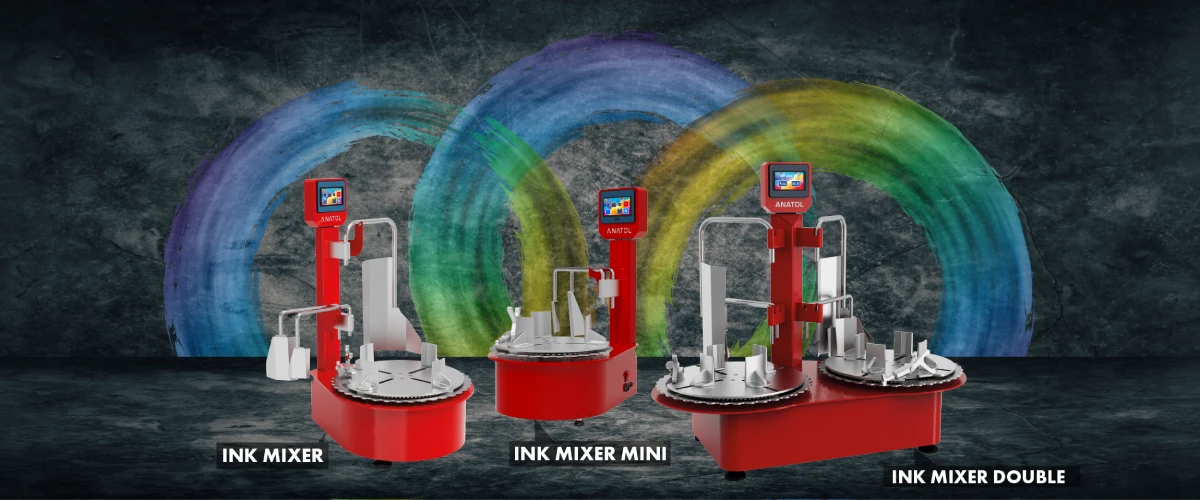Introduction to Ink Mixers in Screen Printing
Ink mixers are essential in screen printing, ensuring ink is properly blended for smooth and consistent prints. Without an ink mixer, inconsistencies in color and texture may arise, leading to defects in the final product.
Ink mixers play a crucial role in screen printing, ensuring uniform ink consistency for high-quality and durable prints on textiles, plastics, metal, wood, and other materials. One of the key aspects of this process is the proper preparation of ink, which must be homogeneous, free of lumps, and maintain a stable color. This is exactly why specialized ink mixers are used.
In this article, we will explore why an ink mixer is necessary, its key advantages, popular models available on the market, and essential recommendations for its use. Understanding the role of an ink mixer will help print shops achieve more consistent and reliable results while improving production efficiency.
Why is an Ink Mixer Essential in Screen Printing?
A paint mixer is a device used for the automated mixing of printing inks before they are applied in screen printing. Its main task is to ensure a uniform ink consistency, which positively impacts print quality.
Key Reasons to Use a Mixer:
- Even ink mixing for consistent color. Any deviations in mixing can lead to uneven tones, negatively affecting the final result. Consistency is crucial in large production runs where color deviation can create noticeable differences between batches.
- Prevention of lumps and pigment settling. During storage, ink can separate, and pigments may settle at the bottom. The mixer prevents this, ensuring uniformity and avoiding printing defects.
- Time-saving and reduction of printing defects. Automated mixing speeds up the ink preparation process, reducing the risk of defects and making the overall production process more efficient.
- Cost-effectiveness. Using a paint mixer ensures minimal ink waste, as manual mixing often results in unnecessary losses due to improper dispersion.
- Repeatability. A mixer provides reliable and repeatable ink consistency, making it easier to maintain high-quality prints over multiple production cycles.
Functional Capabilities of Formulator Ink Mixers
The Formulator series of ink mixers, including the Mini, Large, and Double models, are designed to enhance the efficiency of screen printing by ensuring precise ink preparation. These mixers share several key functional capabilities:
- Variable speed mixing – allows regulation of the process according to the requirements of specific ink, accommodating different viscosities and pigment densities.
- Bidirectional mixing – ensures even pigment distribution by rotating the mixing blades in both clockwise and counterclockwise directions.
- Programmable modes – the ability to save mixing parameters (speed, direction, time) for reuse, ensuring consistency across multiple batches.
- Touchscreen control – a user-friendly interface for adjusting settings, simplifying operation and reducing errors in ink preparation.
- Durable construction – steel casing for longevity and reliability in operation, designed to withstand rigorous use in industrial environments.
- Quick blade change capability – adaptation for different types and volumes of ink, allowing the mixer to be used for a variety of printing applications.
- Reduced manual labor – automating the mixing process helps reduce physical strain on workers and minimizes variability in ink consistency caused by human error.
Differences Between Formulator Models
- Formulator Mini Screen Printing Ink Mixer – a compact mixer suitable for mixing ink in small containers (from 1 quart to 1 gallon). Ideal for small print shops and individual projects where space and batch size are limited.
- Formulator Large Screen Printing Ink Mixer – a more powerful option for handling larger volumes (from 1 quart to 6 gallons). Suitable for mid- to large-scale production runs that require consistent ink preparation.
- Formulator Double Screen Printing Ink Mixer – a model that allows mixing two containers of ink simultaneously, significantly speeding up the material preparation process. Perfect for high-production environments where efficiency is critical.
How to Use an Ink Mixer Properly
To achieve the best results when mixing ink, follow these key recommendations:
- Choose the right mixing container. The container size should match the amount of ink to ensure even distribution and prevent spillage.
- Adhere to the mixing time. Each ink has its own characteristics, so follow the manufacturer’s recommendations on mixing duration to achieve optimal consistency.
- Regularly clean the mixer. Ink residues can accumulate on the blades, leading to reduced mixing quality. Proper maintenance extends the life of the equipment and prevents cross-contamination between different ink colors.
- Store mixed ink properly. Once ink is mixed, store it in airtight containers to prevent drying or pigment separation. Label each batch with the date and color information for easy tracking.
- Conduct test prints. Before using the mixed ink in production, perform test prints to check for color accuracy and consistency. Adjust mixing parameters if necessary.
For a better understanding of the ink mixing process, we recommend watching a demonstration video on mixer operation
Conclusion and Recommendations
An ink mixer is a fundamental tool in screen printing, streamlining the ink preparation process to ensure uniform consistency and high-quality results. By automating ink mixing, print shops can significantly reduce errors caused by uneven blending, pigment separation, and ink inconsistencies, ultimately improving the final print output.
Beyond enhancing color accuracy, an ink mixer also contributes to increased efficiency and cost-effectiveness. It minimizes ink waste, reduces manual labor, and ensures consistent results across different production batches. For businesses looking to scale their operations and maintain industry-leading printing standards, investing in a high-performance ink mixer is a strategic decision.
Selecting the right ink mixer depends on the scale of production, ink volume requirements, and workflow demands. Whether opting for a compact model for small projects or a high-capacity dual-container mixer for industrial use, choosing the right equipment ensures smooth and efficient ink preparation.
By integrating an ink mixer into their workflow, screen printers can achieve greater precision, maintain consistent color reproduction, and optimize productivity, making it an indispensable asset for any print shop aiming for superior results.

